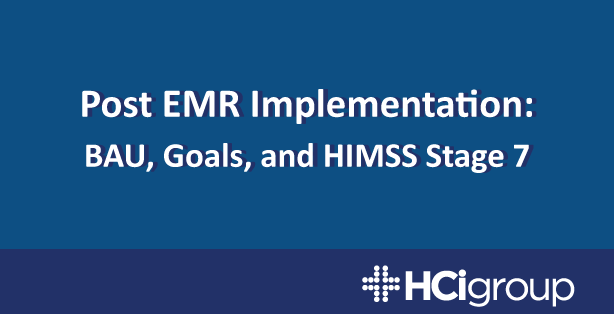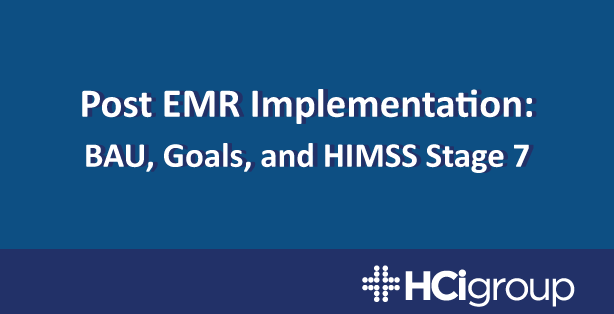Post EMR Implementation: BAU, Goals, and HIMSS Stage 7


Post EMR implementation, healthcare organizations will look to get back to business as usual as soon as possible. Once BAU is established, attention turns to realizing the many benefits that the new EMR system can provide. The HCI Group’s COO Mike Sinno has led several large-scale EMR implementation projects, and in today’s post, he takes a look at three different areas to consider post EMR implementation. For a more in-depth discussion, be sure to check out our recent interview with Mike where we discuss post-live operation readiness and support.
1) Getting Back to Business as Usual
One of the first and most important things that an organization needs to achieve post implementation is returning to business as usual (BAU). For example, one of the barometers that measure success in the ambulatory world is getting back to your prior level of EMR productivity within a four week period. This is largely contingent on how well you trained and provided at-the-elbow support to bridge the gap between training and first use, and is essential in returning workflows to their normal level.
If your orthopedic surgeon was seeing 40-45 patients per session before implementing the new EMR, they should be seeing that same number of patients four weeks post implementation. Getting back to BAU within a four week period is a key component to an EMR implementation because it allows you to serve your existing user base well. The EMR should not be viewed as a barrier to accomplishing your pre-implementation productivity – it should be viewed as the enabler.
2) Accomplishing All of your Pre EMR Implementation Goals
It isn’t uncommon for organizations to have goals set pre-implementation that they didn’t have time to accomplish. Achieving these goals is a matter of prioritization and commitment – your organization must look at them individually, and understand perceived barriers to accomplishing them.
More often than not, these goals are not realized due to lack of resources, changing priorities or demands from a workflow perspective, or broken governance processes – very seldom is it due to technology. In order to achieve all of the goals that your organization set forth prior to your implementation process, it will be important to align your resources from a utilization standpoint.
Make sure that your organization is properly utilizing both people and money, and these benefits will become more easily achievable post implementation.
3) Preparing for HIMSS Stage 7
Once your organization is back to BAU and you have accomplished the goals that you set prior to implementation, it is time to start looking at the benefits that your new EMR can provide. The goal of any EMR implementation is to allow for better patient care, and by utilizing the new EMR properly, this can be done both efficiently and effectively.
One of the many benefits that your organization can now strive to achieve, for example, is alignment with HIMSS 7 Stages of EMR Adoption. Reaching Stage 7 will be dependent on cohesion within your organization – when HIMSS surveyors come in to your healthcare facility, everybody should be able to answer the same questions. For example, if there are still paper charts on an impatient floor, all of your employees should know their disposition, as well as how quickly these papers needs to get into the EMR. This common understanding will lead to a more cohesive and efficient organization through the implementation of the new EMR.
One of the single most important things to keep in mind with regards to an EMR implementation is that the process is a journey, not a destination. Constantly improving within the new EMR will lead to better patient care, and the ability to operate efficiently. During post implementation, this process begins with getting back to BAU, accomplishing your pre implementation goals, and reaping the benefits that your new EMR has to offer.
For more information on the post optimization phase of an EMR implementation project, make sure to check out the third episode of our Monday Morning Podcast Series, where Mike sits down and goes into full detail on the support phase of an EMR implementation.

